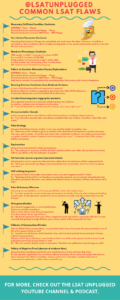The LSAT Logical Reasoning section tests your ability to spot a variety of flaws. Some are as simple as failing to consider a particular possibility, but we can group the others into the category of classic logical fallacies. They’re the type you find in basic logic textbooks.
Many Logical Reasoning questions describe flaws in the abstract, but most speak in terms of the stimulus topic. They’ll say things like: “the arguments fails to consider…(something specific to the topic of that argument).” However, even when the stimulus talks in terms related to that argument, it often refers to a classic flaw.

*** Download my free Common LSAT Flaws PDF here ***
It’s useful to be familiar with such flaws so that you recognize them when they appear, even if the language is in terms of the argument, rather than in the abstract.
Two great websites, Your Logical Fallacy Is and Information is Beautiful, provide basic, well-designed overviews of common logical fallacies. Obviously, neither site is tailored to the LSAT in particular, but beginners may find them helpful.
The guy who made Your Logical Fallacy Is provides funny examples of each fallacy, and all the content is also in one place, infographic-style.
The folks behind Information is Beautiful also posted the same info in a Google Doc, so you can get all their “Rhetological Fallacies” info in one place.
Below, I list each of the fallacies covered by these sites, along with a brief description of each, and provide an example or two (or more) of an actual LSAT question exhibiting that flaw:
(page numbers are for the newest edition of the relevant LSAT PrepTest book – usually Next 10)
1. False Cause (Correlation / Causation)
-presuming that a real or perceived relationship between things means that one is the cause of the other
PrepTest 30 (December 1999 LSAT), S2, Q25 (p61)
PrepTest 37 (June 2002 LSAT), S4, Q17 (p312)
2. Appeal to Emotion
-attempting to manipulate an emotional response in place of a valid or compelling argument
PrepTest 26 (September 1998 LSAT), S2, Q1 (p258)
3. The Fallacy Fallacy
-presuming that because a claim has been poorly argued, or a fallacy has been made, that it is necessarily wrong
PrepTest 31 (June 2000 LSAT), S3, Q23 (p102)
PrepTest 37 (June 2001 LSAT), S2, Q21 (p301)
PrepTest 38 (October 2002 LSAT), S1, Q23 (p329)
4. Ad Hominem (Personal Attack)
-attacking the opponent’s character or personal traits instead of engaging with their argument
PrepTest 19 (June 1996 LSAT), S2, Q14 (p24)
PrepTest 25 (June 1998 LSAT), S4, Q4 (p241)
PrepTest 32 (October 2000 LSAT), S4, Q6 (p139)
PrepTest 34 (June 2001 LSAT), S2, Q1 (p194)
PrepTest 38 (October 2002 LSAT), S1, Q8 (p323)
PrepTest 38 (October 2002 LSAT), S4, Q8 (p344)
5. Burden of Proof
-saying that the burden of proof lies not with the person making the claim, but with someone else to disprove
PrepTest 35 (October 2001 LSAT), S4, Q7 (p242)
6. Ambiguity (Equivocation)
-using a double meaning or ambiguity of language to mislead or misrepresent the truth
PrepTest 34 (June 2001 LSAT), S3, Q12
7. The Gambler’s Fallacy
-assuming that “runs” occur to statistically independent phenomena such as roulette wheel spins
PrepTest 33 (December 2000), S1, Q24 (159)
8. Bandwagon
-appealing to popularity or the fact that many people do something as an attempted form of validation
PrepTest 28 (June 1999 LSAT), S1, Q9 (p324)
PrepTest 28 (June 1999 LSAT), S1, Q19 (p327)
PrepTest 32 (October 2000 LSAT), S4, Q13 (p141)
9. Appeal to Authority
-using the opinion or position of an authority figure, or institution of authority, in place of an actual argument
PrepTest 20 (October 1996 LSAT), S4, Q20 (p75)
June 2007 LSAT, S2, Q17
10. Composition Division (Part-to-Whole)
-assuming that one part of something has to be applied to all, or other, parts of it
PrepTest 19 (June 1996 LSAT), S4, Q3 (p36)
PrepTest 31 (June 2002 LSAT), S3, Q18 (p100)
PrepTest 35 (October 2001 LSAT), S4, S18 (p245)
11. Genetic
-judging something as either good or bad on the basis of where it comes from, or from whom it came
PrepTest 30 (December 1999 LSAT), S2, Q26 (p61)
12. Black or White (False Binary/Dilemma)
-presenting two alternative states as the only possibilities, when in fact more possibilities exist
PrepTest 35 (October 2001 LSAT), S4, Q13 (p243)
PrepTest 38 (October 2002 LSAT), S1, Q11 (p325)
13. Begging the Question (Circular Reasoning)
-presenting a circular argument in which the conclusion was included in the premise
PrepTest 36 (December 2001 LSAT), S1, Q10 (p257)
14. Middle Ground
-claiming that a compromise, or middle point, between two extremes must be the truth
June 2007 LSAT, S2, Q2
***
I didn’t provide examples of the following flaws in actual LSAT questions simply because none came to mind. (This doesn’t necessarily mean they don’t exist on the exam, though.)
If you find an example of an LSAT question exhibiting one of the following flaws, please let me know, and I’ll add it to the list above.
15. The Slippery Slope
– suggesting that if we allow A to happen, then Z will eventually happen too, therefore A should not happen
16. Straw Man
-misrepresenting someone’s argument to make it easier to attack
17. Tu quoque
-avoiding engagement with criticism by turning it back on the accuser – answering criticism with criticism.
18. Personal Incredulity
-assuming that because you found something difficult to understand, or are unaware of how it works, it’s probably not true
19. Special Pleading
-moving the goalposts or making up an exception when a claim is shown to be false
20. Loaded Question
-asking a question that had an assumption built into it so that it couldn’t be answered without appearing a particular way
21. No True Scotsman
-appealing to purity as a way to dismiss relevant criticisms or flaws of an argument
22. Appeal to Nature
-arguing that because something is ‘natural’ it is therefore valid, justified, inevitable, or ideal
23. Anecdotal
-using a personal experience or an isolated example instead of a sound argument or compelling evidence
24. The Texas Sharpshooter
-cherry-picking a data cluster to suit the argument, or finding a pattern to fit a presumption

